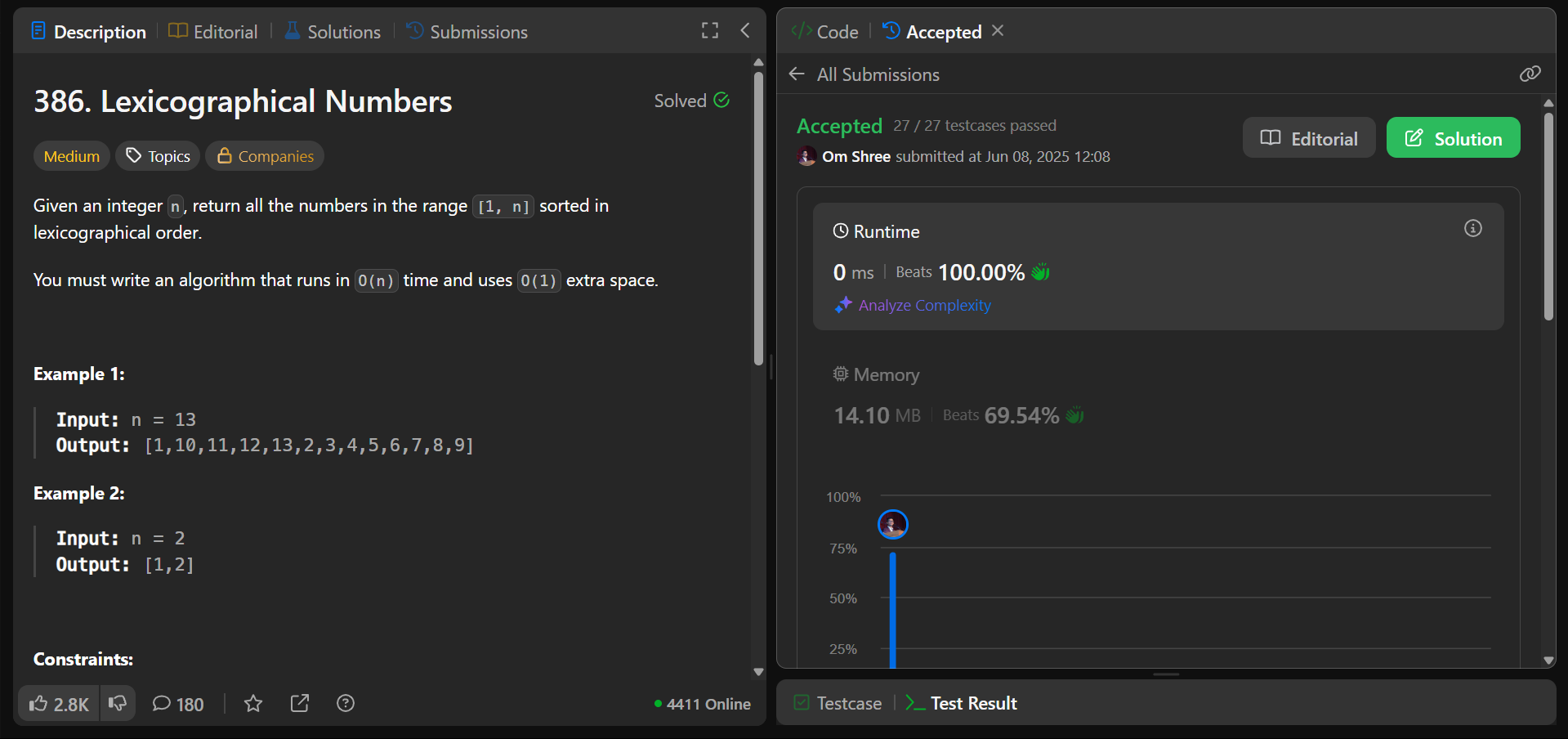Are you struggling with LeetCode 386 Lexicographical Numbers? This comprehensive guide breaks down the optimal solution with detailed explanations, multiple programming language implementations, and expert insights to help you master this medium-difficulty algorithm problem.
📜What is LeetCode 386: Lexicographical Numbers Problem?
LeetCode 386 challenges developers to return all numbers from 1 to n sorted in lexicographical (dictionary) order, not numerical order. This problem tests your understanding of tree traversal algorithms, DFS simulation, and optimization techniques.
Problem Statement and Examples
Given an integer n, return all numbers from 1 to n sorted lexicographically.
Key Difference: Lexicographical vs Numerical Ordering
Numerical Order: 1, 2, 3, 4, 5, 6, 7, 8, 9, 10, 11, 12, 13
Lexicographical Order: 1, 10, 11, 12, 13, 2, 3, 4, 5, 6, 7, 8, 9
Example Test Cases
Example 1:
Input: n = 13
Output: [1,10,11,12,13,2,3,4,5,6,7,8,9]
Explanation: Numbers sorted as strings in dictionary order
Example 2:
Input: n = 2
Output: [1,2]
Explanation: Both numbers maintain lexicographical order
Example 3:
Input: n = 100
Output: [1,10,100,11,12,13,14,...,19,2,20,21,...,29,3,30,...]
🧠Algorithm Strategy: DFS Tree Traversal Simulation
Why Not Sort Strings? Time Complexity Analysis
The naive approach of converting numbers to strings and sorting would result in:
Time Complexity: O(n log n) - due to sorting operation
Space Complexity: O(n) - for string conversion and storage
Our optimized solution achieves:
Time Complexity: O(n) - each number processed exactly once
Space Complexity: O(1) - constant extra space (excluding output array)
Core Algorithm Intuition
The lexicographical order follows a Depth-First Search (DFS) pattern without requiring recursion or additional data structures:
Depth Traversal: From any number, try going deeper by multiplying by 10 (1 → 10 → 100)
Sibling Traversal: If can't go deeper, increment by 1 (10 → 11 → 12)
Backtracking: When hitting boundaries (like 19 or n), backtrack by dividing by 10
Step-by-Step Algorithm Walkthrough
For n = 13, the traversal follows this pattern:
Start with
curr = 1→ Add 1 to resultTry
1 * 10 = 10 ≤ 13→ Go deeper,curr = 10→ Add 10Try
10 * 10 = 100 > 13→ Can't go deeperTry
10 + 1 = 11 ≤ 13→ Move to sibling,curr = 11→ Add 11Continue this pattern: 12, 13, then backtrack to 2, 3, 4, etc.
💻Complete Solution Implementation
C++ Solution (Most Efficient)
class Solution {
public:
vector<int> lexicalOrder(int n) {
vector<int> result;
result.reserve(n); // Pre-allocate for better performance
int curr = 1;
while (result.size() < n) {
result.push_back(curr);
// Try to go deeper (multiply by 10)
if (curr * 10 <= n) {
curr *= 10;
} else {
// Backtrack until we can increment
while (curr % 10 == 9 || curr == n) {
curr /= 10;
}
curr++;
}
}
return result;
}
};
JavaScript ES6+ Solution
/**
* @param {number} n
* @return {number[]}
*/
const lexicalOrder = function(n) {
const result = [];
let curr = 1;
while (result.length < n) {
result.push(curr);
if (curr * 10 <= n) {
curr *= 10;
} else {
while (curr % 10 === 9 || curr === n) {
curr = Math.floor(curr / 10);
}
curr++;
}
}
return result;
};
Python Solution with Type Hints
class Solution:
def lexicalOrder(self, n: int) -> List[int]:
"""
Generate lexicographical order of numbers 1 to n
Time: O(n), Space: O(1)
"""
result = []
curr = 1
while len(result) < n:
result.append(curr)
if curr * 10 <= n:
curr *= 10
else:
while curr % 10 == 9 or curr == n:
curr //= 10
curr += 1
return result
Java Solution
class Solution {
public List<Integer> lexicalOrder(int n) {
List<Integer> result = new ArrayList<>(n);
int curr = 1;
while (result.size() < n) {
result.add(curr);
if (curr * 10 <= n) {
curr *= 10;
} else {
while (curr % 10 == 9 || curr == n) {
curr /= 10;
}
curr++;
}
}
return result;
}
}
Comprehensive Test Cases and Edge Cases
Standard Test Cases
// Test Case 1: Small range
Input: n = 9
Output: [1,2,3,4,5,6,7,8,9]
Explanation: No depth traversal needed
// Test Case 2: Powers of 10
Input: n = 100
Output: [1,10,100,11,12,...,19,2,20,21,...,99]
// Test Case 3: Single digit
Input: n = 1
Output: [1]
Edge Cases to Consider
// Edge Case 1: Minimum valid input
n = 1 → [1]
// Edge Case 2: All single digits
n = 9 → [1,2,3,4,5,6,7,8,9]
// Edge Case 3: Boundary at 10
n = 10 → [1,10,2,3,4,5,6,7,8,9]
// Edge Case 4: Large numbers
n = 50000 → Efficient O(n) performance maintained
Algorithm Complexity Analysis
Time Complexity Breakdown
Overall: O(n) - Each number from 1 to n is visited exactly once
Per iteration: O(1) - Constant time operations (multiplication, division, modulo)
No sorting required: Unlike string-based approaches that need O(n log n)
Space Complexity Analysis
Extra Space: O(1) - Only using a few integer variables
Output Space: O(n) - Required for storing the result array
No recursion stack: Iterative approach avoids stack overflow issues
Performance Comparison
Approach Time Complexity Space Complexity Pros Cons String Sort O(n log n) O(n) Simple to understand Inefficient for large n Recursive DFS O(n) O(log n) Intuitive tree traversal Stack overflow risk Iterative DFS O(n) O(1) Optimal performance Requires algorithm insight
Common Mistakes and Debugging Tips
Frequent Implementation Errors
Mistake 1: Incorrect Backtracking Logic
// Wrong: Not handling boundary cases properly
while (curr % 10 == 9) { // Missing curr == n check
curr /= 10;
}
Mistake 2: Integer Overflow
// Wrong: Not checking multiplication bounds
if (curr * 10 <= n) { // Could overflow for large numbers
curr *= 10;
}
// Better: Add overflow protection for very large n
if (curr <= n / 10) {
curr *= 10;
}
Debugging Strategies
Trace Small Examples: Walk through n=13 step by step
Check Boundary Conditions: Test with n=1, n=9, n=10
Verify Order: Ensure output matches lexicographical expectations
Performance Testing: Validate O(n) complexity with large inputs
Interview Tips and Follow-up Questions
Technical Interview Insights
What interviewers look for:
Understanding of lexicographical vs numerical ordering
Ability to optimize from O(n log n) to O(n) solution
Clean implementation without recursion
Proper handling of edge cases
Potential Follow-up Questions
Question 1: Memory Optimization
"Can you solve this without storing all results at once?"
Answer: Implement as a generator/iterator that yields one number at a time:
def lexical_order_generator(n):
curr = 1
count = 0
while count < n:
yield curr
count += 1
if curr * 10 <= n:
curr *= 10
else:
while curr % 10 == 9 or curr == n:
curr //= 10
curr += 1
Question 2: Range Queries
"How would you find lexicographical numbers between two values?"
Question 3: k-th Lexicographical Number
"Can you find the k-th lexicographical number without generating all previous numbers?"
Related LeetCode Problems
Master these similar problems to strengthen your algorithm skills:
LeetCode 440: K-th Smallest in Lexicographical Order
LeetCode 17: Letter Combinations of a Phone Number
LeetCode 89: Gray Code
LeetCode 131: Palindrome Partitioning
Conclusion
LeetCode 386 demonstrates the power of simulating tree traversal without recursion, achieving optimal O(n) time complexity through clever iteration logic. This problem showcases important concepts:
Algorithm optimization from O(n log n) to O(n)
Space-efficient implementation using O(1) extra memory
DFS simulation without recursion or additional data structures
Boundary handling and edge case management
The key insight is recognizing that lexicographical order follows a predictable DFS pattern that can be efficiently simulated using simple arithmetic operations.
Next Steps for Skill Development
Practice variations with different constraints
Implement in multiple languages to understand language-specific optimizations
Study related tree traversal problems to reinforce the pattern
Time your solutions to verify O(n) performance in practice
Ready to tackle more challenging algorithm problems? The skills learned from LeetCode 386 will serve as a strong foundation for advanced tree traversal and optimization techniques.
If you enjoyed the breakdown, consider hitting that ❤️ and sharing with fellow devs. Let’s keep growing and solving, one problem at a time! 🔍💻
Happy coding! 🚀



